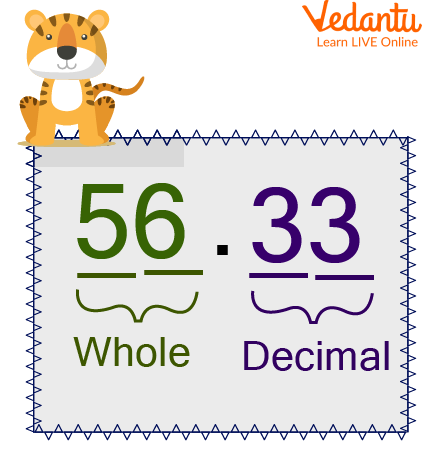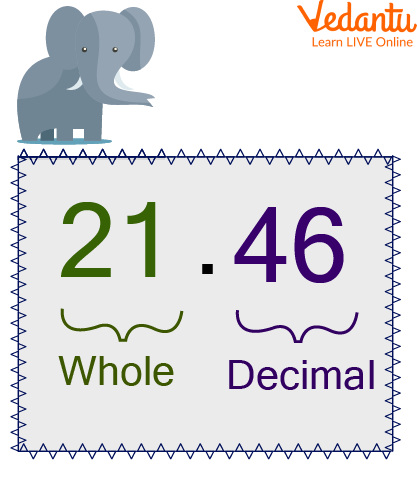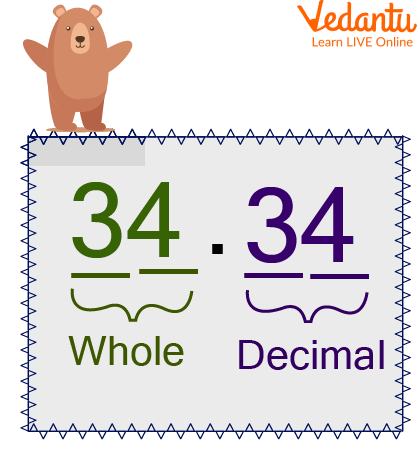




What is the Decimal Number System?
We have learnt that decimals are the extension of our number system. We also know that decimal numbers can be considered fractions with denominators such as 10, 100, 1000, etc. The numbers expressed in decimal form are called decimal numbers or decimals. This article discusses parts of a decimal number, along with decimal number examples. Some practice problems are given underneath for a better understanding of the topic.
For example, 5.2, 4.19, 11.83, etc.
Definition of Decimal Numbers
A decimal number is a number that has a decimal point between the whole number and the fractional part. The point is used to segregate these two parts of the decimal. Thus, it is called a decimal point. The numbers after the decimal point are always smaller than 1.
For example, in the decimal numbers 11.128 and 2.656, 11 and 2 are whole numbers, whereas 128 and 656, following the decimal point, are fractional parts of the number. The fractional part of the decimal number is smaller than 1. In the above examples, the fractional parts of the numbers are 0.128 and 0.656.
Parts of a Decimal Number
Generally, there are two parts of a decimal number:
Whole Number Part
The digits lying to the left of the decimal point form the whole number part. The places begin with ones, then tens, then hundreds, then thousands and so on.
For example, if we have to write the numbers two hundred one and 7 tenths numerically, then we will write it as 201.7. Here, 201 is considered a whole number.
Decimal Part
The decimal point, together with the digits lying on the right of the decimal point, form the fractional part of the decimal part; hence, it is always smaller than 1. The places begin with tenths, then hundredths, then thousandths and so on………
For example, 12.34 has .34 present in its decimal part.
Types of Decimal Numbers
There are two types of decimal numbers, namely:
Terminating
The decimal numbers have only a finite number of digits after the point or in the decimal part. These are also called exact decimal numbers. For example, 12.38, 2.39, 7.3, etc.
Non-terminating
In this type, decimal numbers have an infinite number of digits after the decimal point. Further, non-terminating decimal numbers can be classified into two categories, namely,
Repeating or Recurring Decimal Numbers: A repeating decimal or recurring decimal is a decimal representation of a number whose digits are periodic (repeating its values at regular intervals) and the infinitely repeated portion is not zero.
For example, 123.24242424…….
Non-repeating or non-recurring decimal numbers: These decimals are decimal fractions that will never end and, after the decimal point, even predictably repeat one or more numbers. Non-terminating repeating decimals are rational numbers, and we can represent them as p/q, where q will not equal 0.
For example, 124.1612014……
Decimal Number Examples
Q 1. Identify the whole part and the decimal part:
56.33
Ans: Whole part= 56
Decimal part= 0.33

Decimal Number Example
21.46
Ans: Whole part= 21
Decimal part= 0.46

Decimal Number Example
34.34
Ans: Whole part= 34
Decimal part= 0.34

Decimal Number Example
Practice Questions
Q1. Write the place and place value of the underlined digits:
(a) 8.13
(b) 53.31
(c) 100.92
(d) 11.381
(e) 0.004
Ans.
Hundredths
Tens
Tenths
Hundredths
Tenths
Q2. Express each of the following as decimals.
(a) $\dfrac{37}{100}$
(b) $\dfrac{11}{1000}$
(c) $\dfrac{9}{100}$
(d) $\dfrac{739}{10}$
(e) $\dfrac{1234}{1000}$
(f) $\dfrac{495}{10}$
Ans.
0.37
0.011
0.09
73.9
1.234
49.5
Summary
In this article, we have learned about the definition of decimal numbers, the parts of a decimal number, the types of decimal numbers, and how the decimal point is used to separate the whole part from the fractional or decimal part. Some decimal number examples are discussed to explain to the student the difference that arises in the placement of decimal points at different places. We also learned about the place value of the numbers in the whole number part and the decimal part of a number.
FAQs on Decimal Number System
1. What is the decimal number system and why is it called 'base-10'?
The decimal number system is the standard system we use every day to represent whole numbers and fractions. It is called a 'base-10' system because it is built around ten unique digits: 0, 1, 2, 3, 4, 5, 6, 7, 8, and 9. The value of each digit in a number depends on its position, which is always a power of 10.
2. What is the main function of a decimal point in a number?
The primary function of a decimal point is to act as a separator. It separates the whole number part (on the left) from the fractional part (on the right). For instance, in the number 12.75, the decimal point shows that '12' is the whole part and '75' is the part that is less than one.
3. How does place value work for digits that come after the decimal point?
For digits after the decimal point, the place value represents a fraction of a whole. The value decreases as you move further to the right. The first position is the tenths place (1/10), the second is the hundredths place (1/100), the third is the thousandths place (1/1000), and so on.
4. How do you convert a simple fraction into a decimal?
To convert a fraction to a decimal, you simply divide the numerator (the top number) by the denominator (the bottom number). For example, to convert the fraction 3/4, you would divide 3 by 4, which gives you the decimal 0.75.
5. Can you show an example of expanding a decimal number using its place values?
Certainly. Let's take the number 54.68. We can expand it based on its place values like this:
- 5 is in the tens place (5 x 10)
- 4 is in the ones place (4 x 1)
- 6 is in the tenths place (6 x 1/10 or 0.6)
- 8 is in the hundredths place (8 x 1/100 or 0.08)
So, the expanded form is 50 + 4 + 0.6 + 0.08.
6. Why is the decimal system the most common number system used in our daily lives?
The decimal system is so widely used because it's very intuitive for humans. Many historians believe it originated because humans have ten fingers, which makes counting in groups of ten a natural starting point. We use it for almost everything, including counting money, measuring height or weight, and telling time.
7. How is the decimal system different from the binary system used in computers?
The main difference lies in their base. The decimal system is base-10 and uses ten digits (0-9). The binary system, which computers use, is base-2 and uses only two digits: 0 and 1. While humans find base-10 easy, the simple on/off logic of base-2 is perfect for electronic circuits.
8. What is the difference between terminating and non-terminating decimals?
The difference is whether the digits after the decimal point end or go on forever.
- A terminating decimal has a finite number of digits. For example, 1/4 becomes 0.25, which stops.
- A non-terminating decimal has digits that continue endlessly. For example, 1/3 becomes 0.333..., where the 3 repeats forever.
9. Is a whole number like 7 also considered a decimal number?
Yes, any whole number is technically part of the decimal system. A whole number can be written with a decimal point and a zero without changing its value. For example, the number 7 is the same as 7.0. This shows that whole numbers are just decimals with no fractional part.









